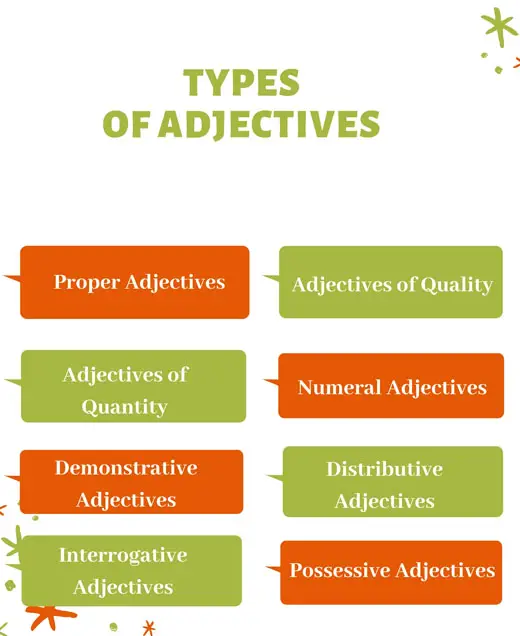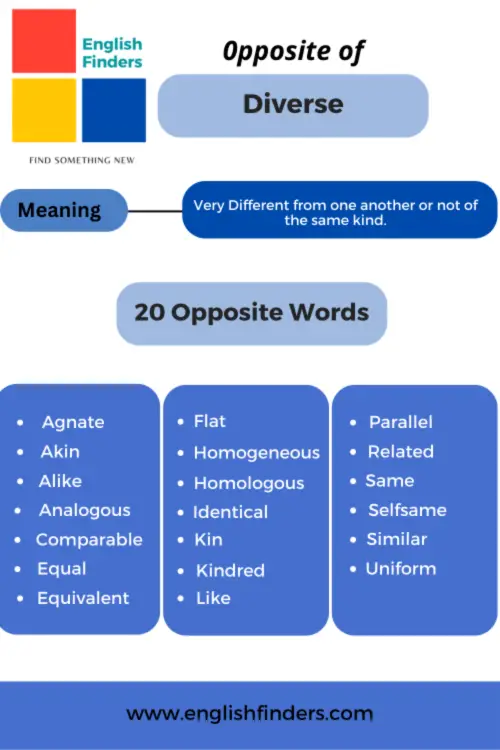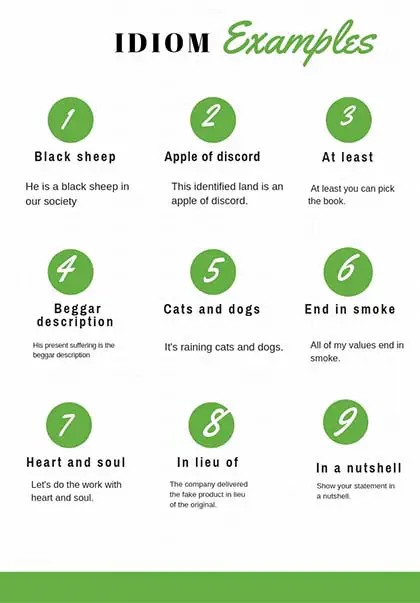Last updated on October 18th, 2024 at 09:46 pm
The Adjective is an exciting lesson in English grammar. Do you know why? Because it can modify the other words of the parts of speech or change the meaning of the whole sentence. Adjectives are usually words that depict the qualities of nouns. They add color, depth, and clarity to our sentences by providing more information about the subject. In this lesson, we’ll explore nine different types of adjectives, providing definitions and examples to help you understand how they work and how to use them effectively.
What is an Adjective?
Quick Navigation
An adjective is a word that describes something about a noun or a pronoun. There are nine types of adjectives in English grammar, and let us see the opinions of the scholars regarding Adjectives in English.
J.C. Nesfield: An Adjective is a word used for qualifying (or adding something to) the meaning of a noun or pronoun.
Wren and Martin: An Adjective is a word used to add something to the meaning of a noun.
Now we can say an Adjective is a word that usually describes a noun or a pronoun and in some cases, other adjectives. Let us see some examples:
Adjectives are marked bold for easy identification:
- He is over-ambitious about the matter.
- She was more famous than at present.
- The boy is so clever.
- He is good at English.
- Would you please give me one hundred dollars?
- The doll looks so beautiful.
- Would you please make some delicious food?
- Mr. Adam is faithful enough to his wife.
- The baby looks attractive.
- I’m happy to see my final examination result.
- It was an incredible journey.
- He is thankful to his friend for solving the problem.
Note: Every Adjective in the above sentences modifies the nouns and pronouns.
Types of Adjectives in English
There are nine types of Adjectives in English grammar. They are:

- Proper Adjectives
- Adjectives of Quality
- Adjectives of Quantity
- Numeral Adjectives
- Demonstrative Adjectives
- Distributive Adjectives
- Interrogative Adjectives
- Possessive Adjectives
- Articles
1. Proper Adjectives
You have already heard about Proper nouns, and proper Adjectives are related to proper nouns. Do you know why? Because Proper Nouns are the name of any person, country, city, day, etc. Proper Adjectives are the adjective form of Proper nouns.
For example: ‘America’ is a Proper noun, but ‘American’ is a Proper Adjective. Similarly, Shakespeare is a Proper Noun, but Shakespearean is a Proper Adjective.
Some examples of proper adjectives are given below. Proper adjectives are marked as bold for easy identification:
- I love Bangladeshi people.
- They met a Japanese company.
- He is reading Shakespearean comedy.
- She needs a Korean friend.
- The older man visits the Christian Church.
2. Adjectives of Quality
An adjective that expresses the nature of a noun or expresses the shape, size, and color of a person, place, or thing is called an adjective of quality.
For example; He is a handsome boy. Here ‘handsome’ is an adjective of quality because it describes the quality or shape of the person.
Some examples of the adjectives of quality are given below: Adjectives of quality are marked as bold for easy identification:
- I see a group of beautiful birds flying in the sky.
- She always loves pink color.
- He is tall enough to join the Army.
- They are too clever to defeat their enemies.
- You look so gorgeous.
3. Adjectives of Quantity
An adjective used to indicate the amount or estimated amount of a noun or a pronoun is called an adjective of quality. For example, I don’t have enough money to buy a car, and here enough is an adjective of quantity.
Some examples of adjectives of quantity are given below: Adjectives of quantity are marked as bold for easy identification:
- I had many friends in my school life.
- He sold his bike, got some money, and rented an apartment.
- It would be best if you had much hard work to achieve success.
- A few numbers of people can reach their destination.
- Most of the boys were absent from the class.
4. Numeral Adjectives
An adjective that describes the number of a noun or pronoun number is called a numeral adjective. In short, the words indicating numbers are considered numeral adjectives. These adjectives indicate the quantity, order, and position of nouns.
For example; He has remained in the first position in the class for many years. Here ‘first’ is the numeral adjective because it states the number of ranks of the person.
Some examples of adjectives of quantity are given below: Numeral adjectives are marked as bold for easy identification:
- We are three friends playing on the field.
- He is the last person to attend the meeting.
Numeral adjectives are of three kinds. They are:
- Definite Numeral Adjectives
- Indefinite Numeral Adjectives
- Distributive Numeral Adjectives
Definite Numeral Adjectives
Definite numeral adjectives are those types of adjectives that describe the exact number of people or things. Definite numeral adjectives are a set of cardinal and ordinal numbers. For example:
| Cardinal numbers | Ordinal numbers |
| One | First |
| Two | Second |
| Three | Third |
| Four | Fourth |
| Five | Fifth |
| Six | Sixth |
| Ten | Tenth |
| Etc. | Etc. |
Definite numeral adjectives are marked as bold for easy identification.
- He is the first boy in the class.
- I’m the second person to enter the room.
- She reads in class ten right now.
- The boy and his two friends reached the campus.
- Nova claimed the third position in the recent ranking of the sports event.
Indefinite Numeral Adjectives
Indefinite numeral adjectives are those adjectives that don’t show the exact number in contrast to definite numeral adjectives—for example; Few, many, some, all, most, etc.
Indefinite numeral adjectives are marked as bold for easy identification.
- A few numbers of people join the meeting.
- Some of my friends are participating in a football match.
- Most of the students made the same mistake in the examination.
- I have seen many flowers in the garden.
- All of you should follow the code of conduct of the organization.
Distributive Numeral Adjectives
Distributive numeral adjectives are those adjectives that describe a singular noun and a singular verb in a sentence. These adjectives are similar to distributive adjectives. For example, each, every, either, neither, etc.
Distributive numeral adjectives are marked as bold for easy identification.
- Every player on the field plays a good game.
- Please distribute the food to each of them.
- Try to do your job, either.
- Neither you nor your friend obeys your duties.
5. Demonstrative Adjectives
An adjective that indicates something or someone is called a demonstrative adjective—for example, this, that, these, those, etc.
Demonstrative adjectives are marked as bold for easy identification.
- This is the new bike I bought from the showroom.
- Everyone should follow that specific method.
- These boys play beautifully.
- Try to avoid those bad things which are harmful to human life.
6. Distributive Adjectives
An adjective used to indicate each person or thing individually is called a distributive adjective. For example, any, each, either, neither, etc.
Distributive adjectives are marked as bold for easy identification.
- Any of you can find the solution to that problem.
- Each of the boys takes the opportunity.
- I cannot do this either.
- Neither she nor her friend attends college.
- He doesn’t get any help from his teammates.
7. Interrogative Adjectives
Interrogative adjectives are similar to interrogative pronouns. These types of adjectives are used to ask questions about nouns. Let’s see what an interrogative adjective is.
An adjective is used to place before a noun and modifies that noun is called an interrogative adjective, for example, which, whose, what, where, etc.
Interrogative adjectives are marked as bold for easy identification.
- Which clothes did you want to buy?
- Whose book do you prefer most?
- What are the best and easiest ways to learn English?
- Where will you wish to take your lunch?
- Which writer is your favorite in English poetry?
8. Possessive Adjectives
A possessive adjective is used to place before a noun and modify the noun to demonstrate possession or ownership of a particular person or thing.
In other words, possessive adjectives refer to the ownership of a person, place, or thing—for example, my, your, his, her, its, our, yours, mine, etc.
Possessive adjectives are marked as bold for easy identification.
- My parents will arrive here very soon.
- Their garden looks very attractive.
- He forgot to bring his key before came here.
- The company has assigned new projects to its employees.
- It’s my challenging job to find a solution.
- This is our job to obey our parents.
- It’s your responsibility to finish the program.
- I don’t believe it’s a mistake of mine.
9. Articles
Articles are also called adjectives. There are three articles (a, an, the) in English. Articles are classified into two categories. They are:
- Indefinite Articles
- Definite Articles
Indefinite Articles
The article that defines a noun as non-specific is called the indefinite article. In short, ‘a’ and ‘an’ are called indefinite articles. For example:
- I have a laptop.
- This is an apple.
- I want to buy a new bike.
- He is a lazy person.
- She is an M.A.
Definite Articles
The article that defines a noun as specific is called the indefinite article. In short, ‘the’ is called a definite article. For example:
- I see a bird flying in the sky.
- He wants to go to the United States.
- This is the beautiful garden I like most.
- Mr. Khopen decides to tell the story in our class.
- She had the strength to fulfill her dreams.
It is essential to learn Adjectives in proper and accessible ways. This lesson will help us understand the nine adjectives in English grammar, including definitions and examples. However, try to read carefully.
How to Identify Different Types of Adjectives in a Sentence
Identifying adjectives in a sentence can sometimes be tricky, but there are a few strategies you can use:
Ask questions: If you can ask “What kind?” “How many?” “Which one?” or “Whose?” and the word answers that question, it’s likely an adjective.
Look for descriptive words: Adjectives typically describe the noun they accompany.
Check the position: Adjectives usually come before the noun, though sometimes they follow it.
Frequently Asked Questions
What is an Adjective?
An adjective is a word or part of speech that modifies a noun or adds extra information about a noun.
What is the difference between descriptive and proper adjectives?
Descriptive adjectives describe a noun’s qualities, while proper adjectives are derived from proper nouns and are capitalized.
How can I avoid common mistakes with adjectives?
To avoid mistakes, ensure you’re not being redundant and that you’re using the correct type of adjective for your sentence.
Adjective Quiz

Azizul Hakim is the founder & CEO of englishfinders.com. He is a passionate writer, English instructor, and content creator. He has completed his graduation and post-graduation in English language and literature.



